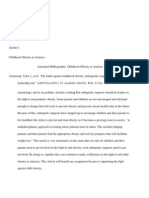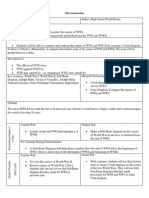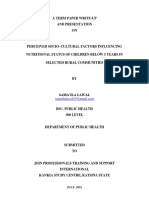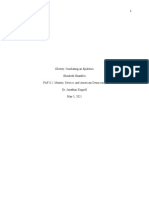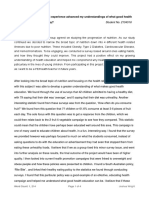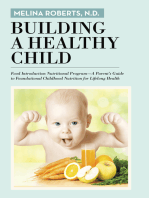0 ratings0% found this document useful (0 votes)
71 viewsGuerrerotext 3
Guerrerotext 3
Uploaded by
api-256950471Copyright:
© All Rights Reserved
Available Formats
Download as PDF, TXT or read online from Scribd
Guerrerotext 3
Guerrerotext 3
Uploaded by
api-2569504710 ratings0% found this document useful (0 votes)
71 views10 pagesOriginal Title
guerrerotext3
Copyright
© © All Rights Reserved
Available Formats
PDF, TXT or read online from Scribd
Share this document
Did you find this document useful?
Is this content inappropriate?
Copyright:
© All Rights Reserved
Available Formats
Download as PDF, TXT or read online from Scribd
Download as pdf or txt
0 ratings0% found this document useful (0 votes)
71 views10 pagesGuerrerotext 3
Guerrerotext 3
Uploaded by
api-256950471Copyright:
© All Rights Reserved
Available Formats
Download as PDF, TXT or read online from Scribd
Download as pdf or txt
You are on page 1of 10
Running Head: OUR FOOD CULTURE 1
Our Food Culture
Alexa Guerrero
University of Texas at El Paso
FOOD CULTURE 2
This annotated bibliography reveals through research and data done by various sources
how we live in society today affects our food culture. Food culture is seen as the study of
food as it relates to the history, progression, and future development of society. This is
extremely evident in how schools, families, the media, marketing, and even the government are
affecting how our society is developing. The purpose behind this annotated bibliography is to
outline each factor that has contributed to todays food culture. My focus was finding articles,
news reports that stated how our habits and our environment affect our food choices making our
own food culture for this generation. How does our food culture compare to that of the past
generations?
Annotated Bibliography
1. Abramson, E. (2011, Nov 7) The Family that Eats Together Stays Healthy Together.
Psychology Today. Retrieved from http://www.psychologytoday.com
Summary
This article focuses on how eating on the run affects food health negatively.
Reveals research that families who eat together four to five time in one week have
kids that have healthier eating habits. Discusses how in our fast and busy lives we
want fast food, grab a snack, and cannot eat as a family anymore. This affects
eating behavior in kids and adults by not eating what is at home where food
would be healthier than what is quickly offered outdoors.
Analysis
I believe this article will prove useful because Abramson, being a clinical
psychologist, states the chaotic lives we live are affecting our health dearly. This
is a strong point in my paper why our food habits have worsened. The author
clearly states throughout the whole article eating as a family promotes
psychological richness which induces healthy eating.
FOOD CULTURE 3
Evaluation
The source is credible due to the author being a clinical psychologist and the
article comes from a credible website. The article is not biased in the sense that he
finds our busy society does contributes to our declining food health but it is also
the familys responsibility to keep good habits and consider the health and
psychological consequences their kids can face.
2. CBS News. (2010, Jan 12) How Americans Eat Today. CBSNews. Retrieved from
http://www.cbsnews.com
Summary
This news article addresses how much American eating habits have changed since
1971. Katherine Brooking, a nutritionist and contributor to Cooking Light
Magazine, tells how eating habits have worsened instead of bettered. This article
reveals how eating together as a family has decreased, and portion size and calorie
intake has increased leading to overweight or obese children and adults.
Compares eating habits of 1960s to 2000s in percentages revealing the dramatic
change in food culture shared in America before and today.
Analysis
This news article also comes with a video that sheds more information on the
article it came with. I found it very useful to my research due to how our culture
in society affects our food habits. This is one of main strong points I want to
argue: the advancement in our society is negatively affecting our health.
Evaluation
I believe this source is entirely credible, due to the research done and data
gathered. The research done confirms how drastically our choices relating to our
meals have affected us. I do not believe this source is biased, but it is in fact
revealing.
3. Khan, T., Powell, L. M., & Wada, R. (2012). Fast Food Consumption and Food Prices:
Evidence from Panel Data on 5th and 8th Grade Children. Journal Of Obesity, 1-
8. doi:10.1155/2012/857697
FOOD CULTURE 4
Summary
This article provides great insight into how fast food and its prices make it widely
available to the age group ranging from adolescence to adulthood. It compares the
prices of fast food and prices of food bought for home consumption. It mentions
also how frequent and important out-of-home restaurants are to this age group. It
states how price differences do make an impact on the demand made by
consumers Policies have been to increase taxes in fast food compared to food
youd buy at the market to control the rate of obesity.
Analysis
I would use this article when stating how easily available fast food is to
consumers especially young of age that contributes later to adult obesity. This
article like many is focused on the health towards children, and how prices can
directly affect the consumption made by adolescents.
Evaluation
This source is credible due to research, and observational studies and relates to
fast food restaurants that are popular in the United States that mainly consumed
by teens. Studies go back to the 1970s til recently and demonstrate how eating
habits have worsened. It does specify that this research had some limitations, but
proved individual choices and the positive effects of price increase on fast food.
4. Obama, M. (2010, Jul 12) Remarks to the NAACP National Convention. Weebly.com.
Retrieved from http://www.glaw1311.weebly.com/readings.html
Summary
This article talked about how the food that is fed to today's children in schools
needs to be changed. She mentions that every one in three children is found with
obesity. The race that tends to be found with obesity more than other races are
African Americans. She talks about how life was then when she was child and
how life is now with all the children of the United States. How exercise is not
being implemented, and how fast-food and unhealthy food choices being offered
in school are contributing to the rise of obesity.
Analysis
I would use this article in addressing schools are a major influence to our food
culture. Not only what is being fed to the children in school but also the lack of
physical exercise that is current in children today. It argues that schools need to be
a healthy environment for our nations children to have a better and healthier
future.
FOOD CULTURE 5
Evaluation
I believe this article is credible and states medical fact and research. I do believe,
however it is biased in the sense how Michelle Obama brings up her own personal
past and how the decline in food health is affecting minorities, especially in
African Americans. She compares the lifestyle lived in the past was much
healthier than today although this may be proven true, I believe it is addressed as
an opinion.
5. Ouwens, M. A., Cebolla, A. A., & van Strien, T. T. (2012). Eating style, television
viewing and snacking in pre-adolescent children. Nutricion Hospitalaria, 27(4),
1072-1078. doi:10.3305/nh.2012.27.4.5805
Summary
This article demonstrates how TV viewing impacts food habits in children and
adults. Evidence did not show that eating food in front of the TV directly leads to
obesity right away in children but continuous snacking (which is common in front
of the TV) can lead to negative eating habits. Bad habits can be controlled by
good parental role models. Emotional snacking is more common in adults than in
children, which is important due to adults are more directly influenced by the
television and its ads.
Analysis
I interpreted this article as in TV viewing while we eat is becoming more common
while we eat young and old. I feel if adults eat in front of the TV it starts off bad
habits at home and later affects the children psychologically to eat food out of
home like the adults and carrying out the bad habits. I would use this article in
demonstrating habits performed at home contribute greatly into the behaviors we
carry out in society, by the method in which we consume food.
Evaluation
I consider this article extremely credible because the trials conducted to find the
results used a large group of boys and girls which provides a wide range of data. I
would say this article is unbiased due to the way the research was conducted.
6. Roblin, L. (2007). Childhood obesity: food, nutrient, and eating-habit trends and
FOOD CULTURE 6
influences. Applied Physiology, Nutrition & Metabolism, 32(4), 635-645.
doi:10.1139/H07-046
Summary
In this article, it starts off stating facts on how the numbers of obese and
overweight children have tripled over the past thirty years. Outlines the habits that
children follow today compared to the past in Canada. This article, however, also
covers data received from the United States. It states the causes of how obesity
occurs in children. It charts the food groups that are consumed by children today.
It also specifically states activities that were common in the past and activities
that are done today and how they prevent or cause obesity. It states how children
are influenced by the media, marketing, schools, and families.
Analysis
This is a very powerful article demonstrating how childrens habits today
contribute greatly to their food health decline. It mentions each outlet that
children are exposed to and how each category whether it be school, home, to
watching television affects their food habits and preferences. It will contribute
greatly in my paper to proving how society is today is the result of such health
decline among children.
Evaluation
This source is extremely credible and quite specific on all the topics it addresses
done from studies, research, and observation over the past years. Although the
research was conducted in Canada, it remains useful due to some data is
compared to the United States. I will say it is not biased due to being completely
objective on how children are affected solely by their environment.
7. Warner, J. (2010, Nov 25) Junking Junk Food. Weebly.com. Retrieved from
http://www.glaw1311.weebly.com/readings.html
Summary
This article takes a different approach to our food culture. It believes personal
responsibility and our culture determine our eating habits. The government
interfering and removing unhealthy foods from schools and regulating food
industries will not do anything because it does not change the culture we live in
which according to this article is what we are ruled by.
FOOD CULTURE 7
Analysis
I extremely believe this article will be more than useful in my research paper
because it addresses that what and how we consume is directly tied to the culture
we live in today. I will use this article in arguing my point that society has a firm
grip in our decisions in healthy food decisions because of the way we view food.
Evaluation
This article is indeed credible, due to the events and data presented in this article.
It is backing up their point of view towards what will contribute a shift in our food
culture for the better. This source is biased due to the opinion it has on the
governments methods in changing our food culture.
8. Zimmerman, F. J., & Shimoga, S. V. (2014). The effects of food advertising and
cognitive load on food choices. BMC Public Health, 14(1), 1-18.
doi:10.1186/1471-2458-14-342
Summary
In this article it addresses how advertisement of food affects an adults food
choices. Research was done on two groups: one group was shown food
advertisements while the other group was not. The groups were then put to the
test having healthy snacks and unhealthy snacks laid out on the table during a
break. The group whom food advertisements were exposed to chose the unhealthy
snacks more than the other group. It also tested the groups in demanding high-
cognitive tasks and low cognitive tasks and the group placed under high cognitive
tasks consumed much more unhealthy snacks than the other group.
Analysis
I believe this article will prove most useful to my research due to it specifically
correlates how social media affects food choices. It links how food advertisements
directly influence an individuals food choice. It also links when put under mental
stress which society induces more today affects an individuals eating habits
negatively. This is a strong point in my research.
Evaluation
This source is extremely credible, and purely observational research was done to
get a conclusion. There was no hint of an opinion in this article making it
completely unbiased.
FOOD CULTURE 8
9. Zandian, M., Ioakimidis, I., Bergstrm, J., Brodin, U., Bergh, C., Leon, M., & ...
Sdersten, P. (2012). Children eat their school lunch too quickly: an exploratory
study of the effect on food intake. BMC Public Health, 12(1), 351-358.
doi:10.1186/1471-2458-12-351
Summary
This article focuses on the eating behavior of children during school rather than
what they eat. It states that eating behavior such as eating quickly (which happens
in mostly in every school) affects food intake and regulation to what they
consume. Studies were done conducting experiment in accelerating and
decelerating food intake. It also states eating quickly is an eating pattern followed
by most obese people and when food intake is increased which leads to weight
gain and can produce metabolic disorders.
Analysis
I would use this article in the argument that school is one of the main influences
in our society in the food culture we have seemed to adopt. It is an interesting
study to see how in school the speed we consume our food affects our food habits
later. Its proven that eating slower reduces the amount in which one consumes.
Evaluation
This source is indeed credible due to that this source is conducted by thorough
studies, research, and trials. It gives an un-biased conclusion that lack of food
moderation is affected by school and carried out into society.
10. Zinczenko, D. (2002, Nov 23) Dont Blame the Eater. Weebly.com. Retrieved from
http://www.glaw1311.weebly.com/readings.html
Summary
This article addresses how personal responsibility made towards our food choices
is hard to maintain in the way we live society today. It mentions how Type 2
diabetes which was a rare genetic disorder in children is now found in thirty
percent of child diabetes cases. It also states how fast food restaurants although
they display their calorie intake for their items it can be confusing or misleading
to read and understand for some people.
FOOD CULTURE 9
Analysis
My response to this article was it is hard to be responsible and healthy in todays
society and will take true will and determination to change food habits shared in
America. I would use it to argue the effect society has on our personal choices
when it comes to the decisions we make about our meals and how they are
declining our health.
Evaluation
I believe this source is credible and proves a point in how even though we know
better we continue on the same patterns in our food choices. The article is credible
due through its passage it is supported by medical research. I do believe, though,
it comes from a point of view making it a biased source.
FOOD CULTURE 10
You might also like
- Sample Request For Enforcement of Sanctions Order in CaliforniaDocument2 pagesSample Request For Enforcement of Sanctions Order in CaliforniaStan Burman100% (1)
- Childhood Obesity 1 PPT PresentationDocument37 pagesChildhood Obesity 1 PPT Presentationapi-2188405580% (1)
- Annotated BibliographyDocument6 pagesAnnotated Bibliographyapi-238017376No ratings yet
- Marzano Lesson PlanDocument2 pagesMarzano Lesson Planapi-267635949No ratings yet
- Weston Wrzesinski - Synthesis PaperDocument5 pagesWeston Wrzesinski - Synthesis PaperCaronakidNo ratings yet
- Annotated BibligoraphyDocument9 pagesAnnotated BibligoraphysamanthaNo ratings yet
- Literature Review On Eating HabitsDocument8 pagesLiterature Review On Eating Habitsea4hasyw100% (1)
- Falkn LitreviewDocument12 pagesFalkn Litreviewapi-242942500No ratings yet
- Development of Poor Eating Habits Among TeenagersDocument20 pagesDevelopment of Poor Eating Habits Among TeenagersRadha SewnalNo ratings yet
- Childhood ObesityDocument6 pagesChildhood Obesityapi-301735807No ratings yet
- UWRT 1102 Group ProposalDocument2 pagesUWRT 1102 Group ProposalRileyMcClellanNo ratings yet
- Literature Review On Childhood Obesity ResearchDocument6 pagesLiterature Review On Childhood Obesity Researchc5nrmzsw100% (1)
- Child Obesity Literature ReviewDocument5 pagesChild Obesity Literature Reviewea3mfh42100% (1)
- Annotated Bibliography RevisionDocument13 pagesAnnotated Bibliography RevisionsamanthaNo ratings yet
- Digestive Wellness for Children: How to Stengthen the Immune System & Prevent Disease Through Healthy DigestionFrom EverandDigestive Wellness for Children: How to Stengthen the Immune System & Prevent Disease Through Healthy DigestionNo ratings yet
- Nutrition and Childhood ObesityDocument8 pagesNutrition and Childhood ObesityErick MuthengiNo ratings yet
- Literature Review FinalDocument11 pagesLiterature Review Finalapi-253949835No ratings yet
- Literature Review Article On Childhood ObesityDocument8 pagesLiterature Review Article On Childhood Obesityc5qvf1q1100% (1)
- I3k2c Bd9usDocument32 pagesI3k2c Bd9usUsman Ahmad TijjaniNo ratings yet
- Health Issues Involving Childhood ObesityDocument5 pagesHealth Issues Involving Childhood Obesityapi-610022486No ratings yet
- Reading Text 3 - Healthy Eating in AmericaDocument5 pagesReading Text 3 - Healthy Eating in AmericaRifky FikrullahNo ratings yet
- School Nutrition Research PaperDocument6 pagesSchool Nutrition Research Paperapi-303011873No ratings yet
- Stacey Luneke ResearchfinalDocument9 pagesStacey Luneke Researchfinalapi-309088550No ratings yet
- Writing Project 3-5Document10 pagesWriting Project 3-5api-456365943No ratings yet
- Health StatementDocument5 pagesHealth Statementapi-423343480No ratings yet
- Patel Janu ReportDocument1 pagePatel Janu Reportapi-542787928No ratings yet
- Annotated BibliographyDocument9 pagesAnnotated Bibliographyapi-439295001No ratings yet
- Childhood Obesity Literature Review EssaysDocument7 pagesChildhood Obesity Literature Review Essaysea3d6w9v100% (1)
- Thesis Final Na To (Maica)Document42 pagesThesis Final Na To (Maica)John-Rey Prado100% (1)
- The Impact of Consuming Junk Food On The Bodies of A Children Ages 8altheagilmartDocument4 pagesThe Impact of Consuming Junk Food On The Bodies of A Children Ages 8altheagilmartMary Joy RoblesNo ratings yet
- Child Obesity in America Literature ReviewDocument10 pagesChild Obesity in America Literature Reviewapi-254067841No ratings yet
- Introduction Bagay 1 1Document3 pagesIntroduction Bagay 1 1aronslayer2007No ratings yet
- Shankles-Paf 112 Final PaperDocument7 pagesShankles-Paf 112 Final Paperapi-548632096No ratings yet
- The Final Nutrition Revised!!!!!Document14 pagesThe Final Nutrition Revised!!!!!api-280378179No ratings yet
- Clperez LitreviewfinalDocument11 pagesClperez Litreviewfinalapi-284975021No ratings yet
- ABDURRAHIMTPDocument32 pagesABDURRAHIMTPUsman Ahmad TijjaniNo ratings yet
- 1 - Final Simaly Rojas Research PaperDocument6 pages1 - Final Simaly Rojas Research Paperapi-341533604No ratings yet
- Weebly ReportDocument4 pagesWeebly Reportapi-320841473No ratings yet
- Literature Review Obesity ChildhoodDocument8 pagesLiterature Review Obesity Childhoodafdttjujo100% (1)
- Childhood Obesity English 102Document6 pagesChildhood Obesity English 102jbell48No ratings yet
- Final Draft The Epidemic of Child Obesity in America 112514Document14 pagesFinal Draft The Epidemic of Child Obesity in America 112514api-269040739No ratings yet
- Carbo News 2006Document4 pagesCarbo News 2006s.sabapathyNo ratings yet
- Global Issues ReportDocument13 pagesGlobal Issues Reportapi-439295001No ratings yet
- Literature Review About Childhood ObesityDocument5 pagesLiterature Review About Childhood Obesityd0vidihujam3100% (1)
- De English Mla Argumentative EssayDocument6 pagesDe English Mla Argumentative Essayapi-732785416No ratings yet
- Literature Review Childhood ObesityDocument4 pagesLiterature Review Childhood Obesityc5j07dce100% (1)
- AnnotatedsourcelistDocument13 pagesAnnotatedsourcelistapi-345396720No ratings yet
- Thesis Statement For Eating Disorders PaperDocument6 pagesThesis Statement For Eating Disorders Paperveronicarogerskansascity100% (2)
- Obesity Dissertation ExampleDocument7 pagesObesity Dissertation ExampleBuyDissertationPaperCanada100% (1)
- Ppe 310-SigassignmentfinalDocument9 pagesPpe 310-Sigassignmentfinalapi-308414867No ratings yet
- Building a Healthy Child: Food Introduction Nutritional Program—A Parent’S Guide to Foundational Childhood Nutrition for Lifelong HealthFrom EverandBuilding a Healthy Child: Food Introduction Nutritional Program—A Parent’S Guide to Foundational Childhood Nutrition for Lifelong HealthNo ratings yet
- Isearch Paper Draft 1Document14 pagesIsearch Paper Draft 1api-283977895No ratings yet
- Obesity Prevention for Children: Before It's Too Late: A Program for Toddlers & PreschoolersFrom EverandObesity Prevention for Children: Before It's Too Late: A Program for Toddlers & PreschoolersNo ratings yet
- Research Log 1Document14 pagesResearch Log 1api-509987244No ratings yet
- Research ProposalDocument3 pagesResearch Proposalapi-336898508100% (1)
- The Plant-Based Baby and Toddler: Your Complete Feeding Guide for the First 3 YearsFrom EverandThe Plant-Based Baby and Toddler: Your Complete Feeding Guide for the First 3 YearsNo ratings yet
- Final Draft Essay 4Document9 pagesFinal Draft Essay 4api-704338092No ratings yet
- Edec 331-Final Group Paper2Document19 pagesEdec 331-Final Group Paper2api-267001080No ratings yet
- Junk Food Ban in SchoolsDocument6 pagesJunk Food Ban in SchoolsClaire CavalliniNo ratings yet
- Literature Review EssayDocument11 pagesLiterature Review Essayapi-30219133350% (2)
- Project 2 Annotated BibDocument13 pagesProject 2 Annotated BibAddison EarleNo ratings yet
- Paper1 RevisedDocument4 pagesPaper1 Revisedapi-315676274No ratings yet
- Reliability of The Go No Go Association TaskDocument13 pagesReliability of The Go No Go Association Taskgabri93bioNo ratings yet
- t390hvn01.0 Auo 699Document29 pagest390hvn01.0 Auo 699Mike DavidNo ratings yet
- Christmas CarolsDocument4 pagesChristmas CarolsSaanvi SandeepNo ratings yet
- St. Francis Xavier Academy: Learning Plan in Mapeh Grade 10Document12 pagesSt. Francis Xavier Academy: Learning Plan in Mapeh Grade 10Jihil KishaNo ratings yet
- QM 1Document165 pagesQM 1Angelo OppioNo ratings yet
- University of Engineering and Technology, Lahore Department of Electrical Engineering EE 213: Analog and Digital Electronics Circuits Experiment 8Document9 pagesUniversity of Engineering and Technology, Lahore Department of Electrical Engineering EE 213: Analog and Digital Electronics Circuits Experiment 8ZbNo ratings yet
- ICICI Dec 13Document2 pagesICICI Dec 13rakeshsingh9811100% (1)
- Skimming & ScanningDocument2 pagesSkimming & ScanningOndevilla Ronald Allen100% (2)
- Book Summary of Educational Book Introduction To EducationDocument2 pagesBook Summary of Educational Book Introduction To EducationGiovanny Claresta TatoNo ratings yet
- Mastering Python Scientific Computing - Sample ChapterDocument25 pagesMastering Python Scientific Computing - Sample ChapterPackt Publishing33% (3)
- Nursing Diagnosis #1Document8 pagesNursing Diagnosis #1Ynez100% (1)
- An Analysis of Verbal and Visual Sign Found in Hotel Advertisements PosterDocument18 pagesAn Analysis of Verbal and Visual Sign Found in Hotel Advertisements PosterFerdi NandusNo ratings yet
- Beyond Techno-Utopia - Critical Approaches To Digital Health Technologies PDFDocument170 pagesBeyond Techno-Utopia - Critical Approaches To Digital Health Technologies PDFAnonymous axL2lPTNo ratings yet
- App 03 ADocument43 pagesApp 03 Adoyeonkim21No ratings yet
- Cats in The CradleDocument5 pagesCats in The CradleskehlaajNo ratings yet
- Dua For A Troubled ChildDocument1 pageDua For A Troubled Childiqra shoukatNo ratings yet
- Project Initiation (Part 1) : Project Management FMT HanuDocument34 pagesProject Initiation (Part 1) : Project Management FMT HanuPhuc LinhNo ratings yet
- All Calligraphy ItemsDocument101 pagesAll Calligraphy ItemsdhumplupukaNo ratings yet
- McKinsey 7S ModelDocument6 pagesMcKinsey 7S Modelpriyank1256No ratings yet
- Argent & Sable in HeraldryDocument21 pagesArgent & Sable in HeraldryPeter DavidsonNo ratings yet
- English (4.3) Degrees of Comparison of AdjectivesDocument7 pagesEnglish (4.3) Degrees of Comparison of AdjectivesGenevieve MelgazoNo ratings yet
- Library InventoryDocument3 pagesLibrary Inventoryelainealexissarmiento33No ratings yet
- Apstract Book 2020 1 2 Ellenorzesre v1Document76 pagesApstract Book 2020 1 2 Ellenorzesre v1Dr Ezekia SvotwaNo ratings yet
- MGT 550 Module Two AssignmentDocument1 pageMGT 550 Module Two AssignmentJeirel RuizNo ratings yet
- Sheet4ProbPower PDFDocument2 pagesSheet4ProbPower PDFpopNo ratings yet
- BNHL Annual Report-FY23Document177 pagesBNHL Annual Report-FY23KanishaNo ratings yet
- MPU Type of PronounsDocument10 pagesMPU Type of PronounsK Jia HuiNo ratings yet
- Business Mathematics and StatisticsDocument411 pagesBusiness Mathematics and StatisticsParth PatelNo ratings yet


